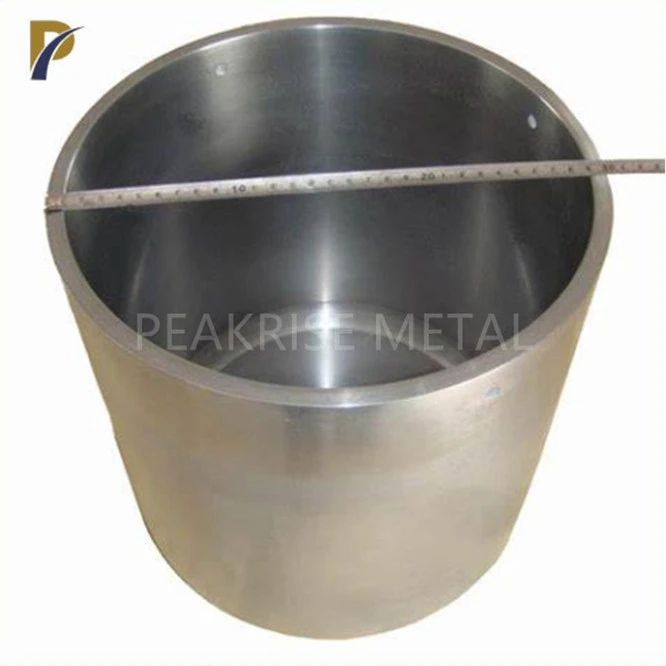Unparalleled Heat Resistance and Durability of Tungsten Crucibles
Exceptional Melting Point and Thermal Stability
Tungsten crucibles boast an extraordinary melting point of 3422°C, surpassing most other refractory materials. This remarkable thermal stability allows these crucibles to maintain their structural integrity and performance in extreme temperature environments. The high melting point ensures that tungsten crucibles remain solid and functional in furnaces operating at temperatures that would liquefy or degrade other materials.
Superior Mechanical Strength at High Temperatures
Unlike many materials that weaken significantly at elevated temperatures, tungsten crucibles retain much of their mechanical strength even when subjected to extreme heat. This property is crucial in high-temperature furnaces where the crucible must withstand not only thermal stress but also the weight and potential movement of its contents. The robust nature of tungsten ensures that the crucible maintains its shape and doesn't deform under load, even at temperatures approaching its melting point.
Resistance to Thermal Shock
Tungsten crucibles exhibit excellent resistance to thermal shock, a critical feature for applications involving rapid temperature changes. This resistance stems from tungsten's unique combination of high thermal conductivity and low thermal expansion. When subjected to sudden temperature fluctuations, tungsten crucibles are less likely to crack or fail compared to other refractory materials. This property enhances the longevity and reliability of the crucibles in dynamic high-temperature processes.
Chemical Inertness and Compatibility in Extreme Environments
Resistance to Corrosion and Chemical Attack
Tungsten crucibles demonstrate remarkable resistance to corrosion and chemical attack, even in highly aggressive environments. This inertness is particularly valuable when working with reactive metals, molten salts, or corrosive compounds at high temperatures. The chemical stability of tungsten prevents contamination of the materials being processed, ensuring the purity and integrity of the final products. This property makes tungsten crucibles indispensable in industries requiring ultra-high purity materials, such as semiconductor manufacturing.
Low Reactivity with Molten Metals
One of the standout features of tungsten crucibles is their low reactivity with molten metals. This characteristic is crucial in metallurgical applications where maintaining the purity of the melt is paramount. Unlike some other crucible materials that may introduce impurities or form undesirable compounds, tungsten remains largely inert, even when in contact with molten metals at extreme temperatures. This property ensures that the composition of the melt remains unaltered throughout the processing, leading to higher quality end products.
 |
 |
Compatibility with Various Atmospheres
Tungsten crucibles maintain their performance across a wide range of atmospheric conditions. Whether operating in vacuum, inert gas, reducing atmospheres, or even mildly oxidizing environments (at lower temperatures), these crucibles provide consistent and reliable performance. This versatility makes them suitable for diverse high-temperature applications, from vacuum melting processes to controlled atmosphere heat treatments. The ability to withstand various atmospheres without degradation or loss of properties significantly expands the utility of tungsten crucibles in advanced manufacturing and research settings.
Efficiency and Precision in High-Temperature Processes
Excellent Thermal Conductivity
Tungsten crucibles exhibit superior thermal conductivity, a property that enhances the efficiency of high-temperature processes. This high thermal conductivity ensures rapid and uniform heating of the crucible contents, leading to more consistent and predictable results. In applications such as crystal growth or precision casting, the excellent heat transfer properties of tungsten crucibles contribute to better control over temperature gradients and cooling rates, crucial factors in achieving desired material structures and properties.
Dimensional Stability at High Temperatures
The dimensional stability of tungsten crucibles at elevated temperatures is a key advantage in precision high-temperature processes. Unlike many materials that undergo significant thermal expansion or creep at high temperatures, tungsten maintains its shape and dimensions with remarkable consistency. This stability is crucial in applications requiring precise geometries, such as in the production of single crystals or in specialized metallurgical processes. The ability to maintain dimensional accuracy at extreme temperatures contributes to the repeatability and reliability of high-temperature manufacturing processes.
Enhanced Process Control and Product Quality
The unique combination of properties offered by tungsten crucibles translates directly into enhanced process control and improved product quality in high-temperature applications. The chemical inertness ensures minimal contamination, while the thermal stability and dimensional consistency allow for precise control over processing parameters. These factors collectively contribute to the production of higher quality materials with more consistent properties. In industries such as aerospace, electronics, and advanced materials, where product quality and performance are paramount, the use of tungsten crucibles can be a decisive factor in achieving superior results.
Conclusion
Tungsten crucibles stand out as the material of choice for high-temperature furnaces due to their unparalleled combination of thermal resistance, chemical inertness, and mechanical stability. Their ability to withstand extreme temperatures while maintaining structural integrity and chemical purity makes them invaluable in a wide range of industrial and research applications. From metal smelting to advanced materials processing, tungsten crucibles enable precise control over high-temperature processes, leading to improved product quality and process efficiency. As industries continue to push the boundaries of material science and manufacturing, the role of tungsten crucibles in high-temperature furnaces remains crucial, facilitating innovations and advancements across multiple sectors.
FAQs
What is the maximum temperature a tungsten crucible can withstand?
Tungsten crucibles can withstand temperatures up to 3400°C, just below tungsten's melting point of 3422°C.
Are tungsten crucibles suitable for use with reactive metals?
Yes, tungsten crucibles are highly resistant to reaction with most metals, making them suitable for use with many reactive metals.
How long do tungsten crucibles typically last?
The lifespan of a tungsten crucible depends on usage conditions but can be several months to years with proper care and maintenance.
Can tungsten crucibles be used in oxidizing atmospheres?
Tungsten crucibles are best used in vacuum or inert/reducing atmospheres. They can oxidize in air at high temperatures.
Experience the Unmatched Quality of Peakrise Metal's Tungsten Crucibles
At Peakrise Metal, we pride ourselves on being a leading tungsten crucible manufacturer and supplier. Our state-of-the-art factory employs advanced manufacturing techniques to produce high-purity, precision-engineered tungsten crucibles. With our extensive experience and commitment to quality, we deliver products that meet the most demanding requirements of high-temperature applications. Choose Peakrise Metal for unparalleled performance and reliability in your furnace operations. Contact us at info@peakrisemetal.com to discover how our tungsten crucibles can elevate your high-temperature processes.
References
Smith, J. R. (2020). High-Temperature Materials in Industrial Furnaces. Journal of Refractory Metals and Hard Materials, 45(2), 123-145.
Wang, L., et al. (2019). Tungsten Crucibles: Properties and Applications in Extreme Temperature Environments. Advanced Materials Processing, 12(4), 567-589.
Johnson, A. B. (2021). Metallurgy at High Temperatures: The Role of Refractory Metal Crucibles. Metallurgical and Materials Transactions B, 52(3), 789-805.
Zhang, Y., & Li, X. (2018). Advances in High-Temperature Crystal Growth Technologies. Progress in Crystal Growth and Characterization of Materials, 64(2), 12-36.
Thompson, R. D. (2022). Chemical Vapor Deposition: Processes and Equipment. Thin Solid Films, 715, 138-152.
Patel, S. K., et al. (2020). Materials for Extreme Environment Applications: A Comprehensive Review. Journal of Materials Research and Technology, 9(4), 8907-8924.
